The two Global Hawk unmanned aerial vehicles (UAV) in NASA's fleet have already begun the Hurricane and Severe Storm Sentinel (HS3) mission a couple of days ago. One of the aircraft flew from California and to Florida, collecting data on Hurricane Leslie in the process.
The UAV are based at the American space agency's Dryden Flight Research Center, near Edwards Air Force Base, California. One of them took off from this location on Thursday and landed at the NASA Wallops Flight Facility, in Virginia, on Friday, September 7, at 11:37 am EDT (1537 GMT).
Both vehicles were designed by the Northrop Grumman Corporation specifically for NASA, and are very well suited for conducting long-term scientific flights. They carry two different sets of instruments, and can remain airborne for a lot longer than conventional research aircraft.
The HS3 mission is centered around using these assets to investigate the various properties of tropical storms and hurricanes. The goal is to gain a deeper understanding of how these atmospheric events form and evolve over time, and also of how they can intensify by so much over a short period of time.
Each Global Hawk UAV can remain in the air for around 28 hours, flying at altitudes of up to 18,288 meters (60,000 feet). They are controlled from special operations centers at both Wallops and Dryden.
The one that landed in Virginia yesterday is the first unmanned aerial vehicle to be operated directly from the East Coast. In about two weeks, the other Global Hawk will join it in Virginia.
“The primary objective of the environmental Global Hawk is to describe the interaction of tropical disturbances and cyclones with the hot, dry and dusty air that moves westward off the Saharan desert and appears to affect the ability of storms to form and intensify,” Scott Braun explains.
The expert holds an appointment as a research meteorologist at the NASA Goddard Space Flight Center (GSFC), in Greenbelt, Maryland. He is also the principal investigator of the HS3 mission.
“Instruments on the 'over-storm' Global Hawk will examine the role of deep thunderstorm systems in hurricane intensity change, particularly to detect changes in low-level wind fields in the vicinity of these thunderstorms,” he goes on to say.
The HS3 mission will go on until early October, NASA says. The UAV will be used during the 2013 and 2014 hurricane seasons as well. Weather experts hope to collect sufficient data by that time to improve existing computer models and weather-prediction abilities.

 14 DAY TRIAL //
14 DAY TRIAL //